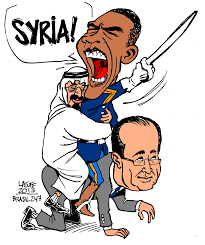sputniknews.com
Saudi Media Waging Information War, Spreading Fake Images of Horror in Aleppo
Sputnik
Middle East
11:13 15.12.2016(updated 11:56 15.12.2016) Get short URL
© AFP 2016/ George OURFALIAN
On Sunday, the Syrian Army officially declared victory in the battle for Aleppo which began more than four years ago. The first clashes in the city broke out on July 19, 2012.
In the last few months, Aleppo has been an important battleground in Syria, engulfed by a conflict between government forces and a number of opposition and extremist groups.
Over the past three weeks, the Syrian Army and militias have freed more than 98 percent of the territory of eastern Aleppo, according to the Russian reconciliation center.
Certain media outlets and popular groups on social networking sites have launched an entire information campaign against Syrian government forces in Aleppo, an article on
Sputnik Arabic read.
They are using pictures from the Gaza Strip as well as photos from 2014 and 2015 as proof of the "atrocities" committed by the Syrian Army against civilians in Aleppo.
Known for its hardline anti-Assad stance, Saudi-owned broadcaster Al Arabiya released a news article on December 14 titled "non-stop coverage of the recent events in Aleppo in details."
The article contained a picture showing emergency workers of the so-called "White Helmets" pulling a Syrian kid out of a ruined building. The boy’s face was covered with blood. However, journalists have repeatedly condemned the "White Helmets" for distributing lies and being engaged with al-Nusra Front.
© Photo: Al Arabiya
Al Arabiya broadcaster used a picture of "White Helmets" workers helping a kid
The very same photo of "White Helmets" members with the same kid can be found on the website of the Aliwaa newspaper in an article dated November 25, 2016. This delivers a heavy blow to Al Arabiya’s claims of "non-stop and relevant" coverage of the situation in Aleppo.
© Photo: Aliwaa
The same photo with the same kid was used by the website of the Aliwaa newspaper in November
Meanwhile, on December 13, popular Arab-speaking Facebook page "Memories ツ ツ" published a post calling for prayers for Aleppo. In just a few hours, the post scored over 14,000 likes, nearly 400 comments and was reposted over 10,000 times.
A noteworthy detail is that at first sight "Memories ツ ツ" seems to be an group publishing entertaining content on a number of topics. However, from time to time, it publishes fake news reports about violence against Syrian people, using fake photos.
Tens of thousands of followers perceive such information as relevant, without checking the facts or the pictures. They believe what they read and see and further distribute the information.
© Sputnik/ Michael Alaeddin
In the description of the above-mentioned post, the author addresses God: "Lord, we have lost all hope, except our hope for you. And we have lost confidence in everything, except for you. We are calling on you to save the people in Aleppo from disaster."
While the Syrian Army was liberating Aleppo and establishing safe corridors for its residents, the group on Facebook published a picture showing a large crowd of refugees with a city in ruins in the background.
This picture was used on the website of BBC Arabic on March 15, 2014 in an article headed "Celebrities across the world are calling on the UN to ease suffering of the Syrian people."
© Photo: BBC
The same photo was used on the website of BBC Arabic in March 2014
On December 13, "Memories ツ ツ" published another post calling for prayers for Aleppo. It received 3,000 likes, 1,000 reposts and a hundred comments. The post featured a picture of a woman crying over the bodies of alleged Syrian kids.
The same picture was used on July 21, 2014 by popular Arab-speaking Twitter blogger @MazenAlhddabi in a post about in an Israeli attack on the Gaza Strip, which took place in 2014.



 https://uploads.disquscdn.com/images/45bc96c3a64c48a900e854f892bf6ed9ba2662dc8390e4e6affc9908fe92b71d.png
https://uploads.disquscdn.com/images/45bc96c3a64c48a900e854f892bf6ed9ba2662dc8390e4e6affc9908fe92b71d.png